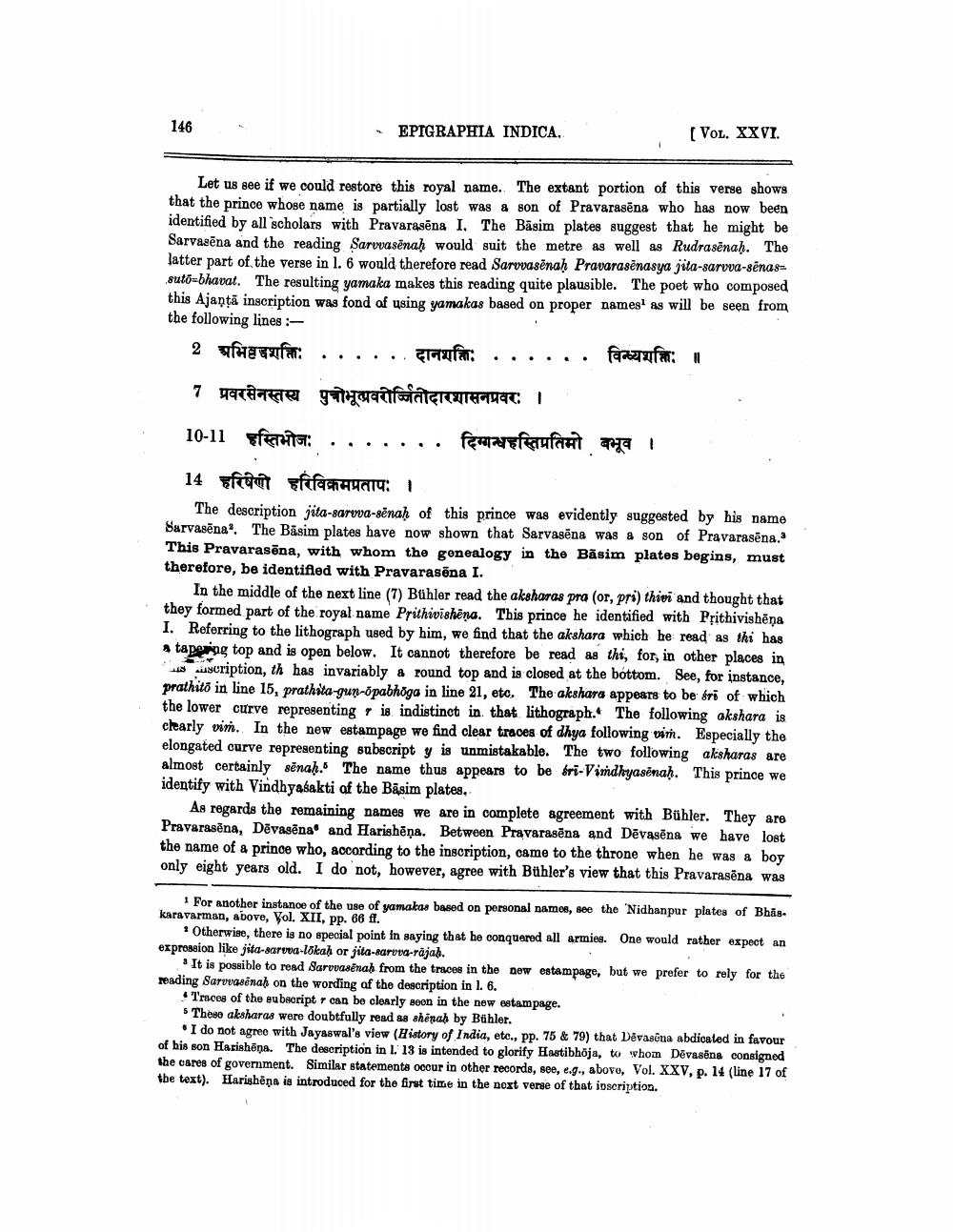________________
146
-
EPIGRAPHIA INDICA.
(Vol. XXVI.
Let us see if we could restore this royal name. The extant portion of this verse shows that the prince whose name is partially lost was a son of Pravarasēna who has now been identified by all scholars with Pravarasēna I. The Bäsim plates suggest that he might be Sarvasēna and the reading Sarvvasēnah would suit the metre as well as Rudrasēnaḥ. The latter part of the verse in l. 6 would therefore read Sarvvasēnah Pravarasēnasya jita-sarvva-8ēnassuto=bhavat. The resulting yamaka makes this reading quite plausible. The poet who composed this Ajaņtā inscription was fond of using yamakas based on proper names' as will be seen from the following lines -
2 wauwafa: ...... grau: ...... farazafe: 1
7 प्रवरसेनस्तस्य पुत्रोभूषवरोजितीदारशासनप्रवरः । 10-11 fetita: ....... Fearasefarufaatana
14 xfaut fifashieca: 1
The description jita-sarva-sēnaḥ of this prince was evidently suggested by his name Sarvasēna. The Bāsim plates have now shown that Sarvasēna was a son of Pravarasēna. This Pravarasēna, with whom the genealogy in the Bāsim plates begins, must therefore, be identified with Pravarasēna I.
In the middle of the next line (7) Bühler read the aksharas pra (or, pri) this and thought that they formed part of the royal name Prithivishēna. This prince he identified with Prithivishēna I. Referring to the lithograph used by him, we find that the akshara which he read as thi has
tapoging top and is open below. It cannot therefore be read as thi, for, in other places in uus suscription, th has invariably & round top and is closed at the bottom. See, for instance, prathito in line 15, prathsta-gun-opabhoga in line 21, etc. The akshare appears to be fri of which the lower curve representing is indistinct in that lithograph. The following akshara is clearly vin. In the new estampage we find clear traces of dhya following vim. Especially the elongated curve representing subscript y is unmistakable. The two following aksharas are almost certainly sēnaḥ. The name thus appears to be fri-Vindhyasēnah. This prince we identify with Vindhyasakti of the Bāsim plates.
As regards the remaining names we are in complete agreement with Bühler. They are Pravarasēna, Dēvasēnao and Harishēna. Between Pravarasēns and Dēvasēna we have lost the name of a prince who, according to the inscription, came to the throne when he was a boy only eight years old. I do not, however, agree with Bühler's view that this Pravarasēna was
1 For another instance of the use of yamakas based on personal namo, so the 'Nidhanpur plates of Bhiskaravarman, above, Vol. XII, pp. 66 ft.
* Otherwise, there is no special point in saying that he conquered all armies. One would rather expect an exprossion like jita-sarva-lokah or jita-sarvua-rajab.
It is possible to read Sarvvasēnah from the traces in the new estampage, but we prefer to rely for the reading Saruvasenah on the wording of the description in l. 6.
• Traces of the subscript can be clearly seen in the new estampage.
Thoso akaharas were doubtfully read as shënah by Bühler.
. I do not agree with Jayaswal's view (History of India, etc., pp. 75 & 79) that Davas na abdicated in favour of bis son Harishēna. The description in L. 13 is intended to glorify Hastibhoja, to whom Dēvasena consigned the cares of government. Similar statements ocour in other records, see, e.g., above, Vol. XXV, p. 14 (line 17 of the text). Harishēna is introduced for the first time in the noxt verse of that inscription.




